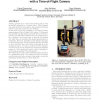Free Online Productivity Tools
i2Speak
i2Symbol
i2OCR
iTex2Img
iWeb2Print
iWeb2Shot
i2Type
iPdf2Split
iPdf2Merge
i2Bopomofo
i2Arabic
i2Style
i2Image
i2PDF
iLatex2Rtf
Sci2ools
116
click to vote
HRI
2011
ACM
2011
ACM
Learning to interpret pointing gestures with a time-of-flight camera
Pointing gestures are a common and intuitive way to draw somebody’s attention to a certain object. While humans can easily interpret robot gestures, the perception of human behavior using robot sensors is more difficult. In this work, we propose a method for perceiving pointing gestures using a Time-of-Flight (ToF) camera. To determine the intended pointing target, frequently the line between a person’s eyes and hand is assumed to be the pointing direction. However, since people tend to keep the line-of-sight free while they are pointing, this simple approximation is inadequate. Moreover, depending on the distance and angle to the pointing target, the line between shoulder and hand or elbow and hand may yield better interpretations of the pointing direction. In order to achieve a better estimate, we extract a set of body features from depth and amplitude images of a ToF camera and train a model of pointing directions using Gaussian Process Regression. We evaluate the accuracy of t...
HRI 2011 | Human Computer Interaction | Human Robot Interaction | Mobile Manipulation | Robot Sensors |
| Added | 28 Aug 2011 |
| Updated | 28 Aug 2011 |
| Type | Journal |
| Year | 2011 |
| Where | HRI |
| Authors | David Droeschel, Jörg Stückler, Sven Behnke |
Comments (0)

